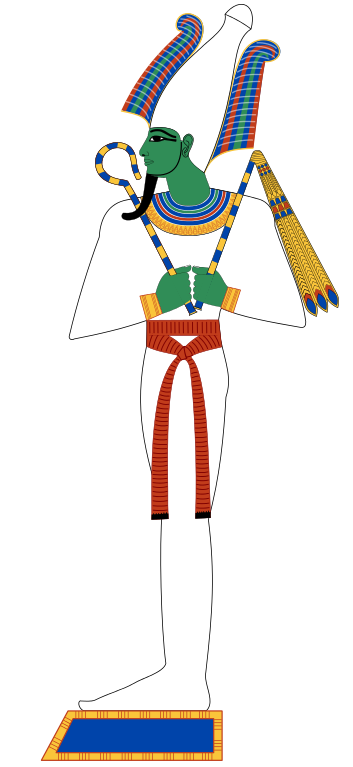Osiris
Osiris (/oʊˈsaɪrɪs/, from Egyptian wsjr, Coptic: ⲟⲩⲥⲓⲣⲉ, romanized: Ousire) is the god of fertility, agriculture, the afterlife, the dead, resurrection, life, and vegetation in ancient Egyptian religion. He was classically depicted as a green-skinned deity with a pharaoh's beard, partially mummy-wrapped at the legs, wearing a distinctive atef crown, and holding a symbolic crook and flail.
Osiris was widely worshipped from at least 3000 BC until the decline of ancient Egyptian religion during the rise of Christianity in the Roman Empire, although some form of his cult possibly began as early as 5000 BC.
Appearance
Osiris is represented in his most developed form of iconography wearing the Atef crown, representing the White crown of Upper Egypt, but with the addition of two curling ostrich feathers at each side. He also carries the crook and flail. The crook is thought to represent Osiris as a shepherd god. The symbolism of the flail is more uncertain with shepherds whip, fly-whisk, or association with the god Andjety of the ninth nome of Lower Egypt proposed.
He was commonly depicted as a pharaoh with a complexion of either green (the color of a reborn, dead body) or black (alluding to the fertility of the Nile floodplain) in mummiform (wearing the trappings of mummification from chest downward).
Mythology
The Pyramid Texts describe early conceptions of an afterlife in terms of eternal travelling with the sun god amongst the stars. Amongst these mortuary texts, at the beginning of the Fourth Dynasty, is found: "An offering the king gives and Anubis." By the end of the Fifth Dynasty, the formula in all tombs becomes "An offering the king gives and Osiris."
Father of Horus
Osiris is the father of the god Horus, whose conception is described in the Osiris myth. The myth describes Osiris as having been killed by his brother Set, who wanted Osiris' throne. His wife, Isis, finds the body of Osiris and hides it in the reeds where it is found and dismembered by Set. Isis retrieves and joins the fragmented pieces of Osiris, then briefly revives him by use of magic, becoming pregnant and giving birth to their son, Horus.
Thereafter Osiris lived on as the god of the underworld. Because of his death and resurrection, Osiris was associated with the flooding and retreating of the Nile and thus with the yearly growth and death of crops along the Nile valley. Since Horus was born after Osiris' resurrection, Horus became thought of as a representation of new beginnings and the vanquisher of the usurper Set.
Worship
Plutarch mentions that (for much later period) two days after the beginning of the festival "the priests bring forth a sacred chest containing a small golden coffer, into which they pour some potable water...and a great shout arises from the company for joy that Osiris is found (or resurrected). Then they knead some fertile soil with the water...and fashion therefrom a crescent-shaped figure, which they cloth and adorn, this indicating that they regard these gods as the substance of Earth and Water." (Isis and Osiris, 39). Yet his accounts were still obscure, for he also wrote, "I pass over the cutting of the wood" – opting not to describe it, since he considered it as a most sacred ritual (Ibid. 21).
In the Osirian temple at Dendera, an inscription describes in detail the making of wheat paste models of each dismembered piece of Osiris to be sent out to the town where each piece is discovered by Isis. At the temple of Mendes, figures of Osiris were made from wheat and paste placed in a trough on the day of the murder, then water was added for several days, until finally the mixture was kneaded into a mold of Osiris and taken to the temple to be buried (the sacred grain for these cakes were grown only in the temple fields). Molds were made from the wood of a red tree in the forms of the sixteen dismembered parts of Osiris, the cakes of "divine" bread were made from each mold, placed in a silver chest and set near the head of the god with the inward parts of Osiris as described in the Book of the Dead (XVII).
As an underworld judge
The idea of divine justice being exercised after death for wrongdoing during life is first encountered during the Old Kingdom in a Sixth Dynasty tomb containing fragments of what would be described later as the Negative Confessions performed in front of the 42 Assessors of Ma'at.
At death a person faced judgment by a tribunal of forty-two divine judges. If they led a life in conformance with the precepts of the goddess Ma'at, who represented truth and right living, the person was welcomed into the kingdom of Osiris. If found guilty, the person was thrown to the soul-eating demon Ammit and did not share in eternal life. The person who is taken by the devourer is subject first to terrifying punishment and then annihilated. These depictions of punishment may have influenced medieval perceptions of the inferno in hell via early Christian and Coptic texts. Purification for those who are considered justified may be found in the descriptions of "Flame Island," where they experience the triumph over evil and rebirth. For the damned, complete destruction into a state of non-being awaits, but there is no suggestion of eternal torture.
